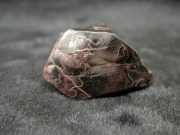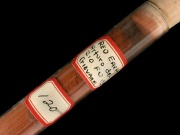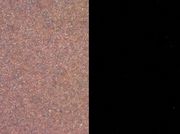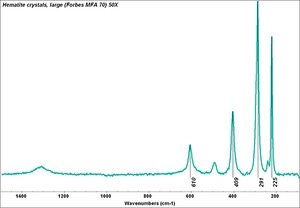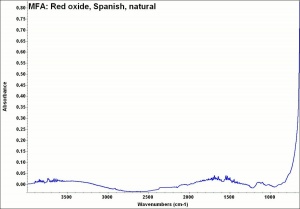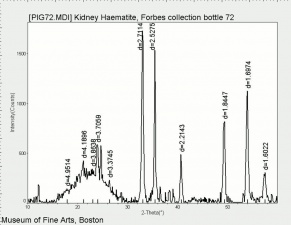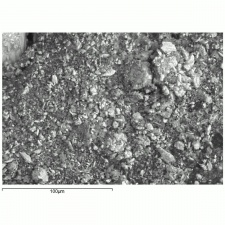Difference between revisions of "Iron oxide red"
| Line 1: | Line 1: | ||
[[File:ph20739hematite2.jpg|thumb|hematite]] | [[File:ph20739hematite2.jpg|thumb|hematite]] | ||
== Description == | == Description == | ||
| + | [[File:120 iron oxide red.jpg|thumb|Iron oxide red]] | ||
| + | Iron oxides produce a wide variety of red shades ranging from light, bright red to a deep purplish red. They can be natural, earth pigments ([[hematite]], [[Indian red]], Venetian red) or synthetically prepared pigments ([[light red]]). All iron oxide reds are stable, permanent pigments with good tinting strength and are the primary colorant in ochers and siennas. | ||
| − | |||
| − | |||
== Synonyms and Related Terms == | == Synonyms and Related Terms == | ||
| − | + | [[File:hematite C100x.jpg|thumb|Hematite at 100x (visible light left; UV light right)]] | |
Pigment Red 101; CI 77491; red iron oxide; red ocher; red ochre (Br.); pozzuolana (It.); terra di Pozzuoli (It.); hématite (Fr.); oxyde fer rouge (Fr.); bengara (Jap.); benigara (Jap.); Roter Ocker (Deut.); Hämatit (Deut.); hematita (Port.); oxeidio toy sidiroy (Gr.); kokkino (Gr.); aimatitis (Gr.); ematite (It.); ijzeroxide rood (Ned.); vermelho de óxido de ferro (Port.); haematite; hematite; Indian red; caput mortuum; rouge; Persian red; Tuscan red; Pompeian red; light red; Venetian red; terra Pozzuoli; English red; angel red | Pigment Red 101; CI 77491; red iron oxide; red ocher; red ochre (Br.); pozzuolana (It.); terra di Pozzuoli (It.); hématite (Fr.); oxyde fer rouge (Fr.); bengara (Jap.); benigara (Jap.); Roter Ocker (Deut.); Hämatit (Deut.); hematita (Port.); oxeidio toy sidiroy (Gr.); kokkino (Gr.); aimatitis (Gr.); ematite (It.); ijzeroxide rood (Ned.); vermelho de óxido de ferro (Port.); haematite; hematite; Indian red; caput mortuum; rouge; Persian red; Tuscan red; Pompeian red; light red; Venetian red; terra Pozzuoli; English red; angel red | ||
| − | |||
== Chemical and Physical Properties == | == Chemical and Physical Properties == | ||
| Line 20: | Line 19: | ||
|- | |- | ||
! scope="row"| Density | ! scope="row"| Density | ||
| − | | 4.2-5.3 | + | | 4.2-5.3 g/ml |
|- | |- | ||
! scope="row"| Refractive Index | ! scope="row"| Refractive Index | ||
Latest revision as of 09:38, 21 September 2022
Description
Iron oxides produce a wide variety of red shades ranging from light, bright red to a deep purplish red. They can be natural, earth pigments (Hematite, Indian red, Venetian red) or synthetically prepared pigments (Light red). All iron oxide reds are stable, permanent pigments with good tinting strength and are the primary colorant in ochers and siennas.
Synonyms and Related Terms
Pigment Red 101; CI 77491; red iron oxide; red ocher; red ochre (Br.); pozzuolana (It.); terra di Pozzuoli (It.); hématite (Fr.); oxyde fer rouge (Fr.); bengara (Jap.); benigara (Jap.); Roter Ocker (Deut.); Hämatit (Deut.); hematita (Port.); oxeidio toy sidiroy (Gr.); kokkino (Gr.); aimatitis (Gr.); ematite (It.); ijzeroxide rood (Ned.); vermelho de óxido de ferro (Port.); haematite; hematite; Indian red; caput mortuum; rouge; Persian red; Tuscan red; Pompeian red; light red; Venetian red; terra Pozzuoli; English red; angel red
Chemical and Physical Properties
| Composition | Fe2O3 |
|---|---|
| Mohs Hardness | 5.5 - 6.5 |
| Density | 4.2-5.3 g/ml |
| Refractive Index | 2.78; 3.01 |
Comparisons
Properties of Common Abrasives
Resources and Citations
- Pigments Through the Ages - http://webexhibits.org/pigments/indiv/overview/redochre.html
- The Dictionary of Art, Grove's Dictionaries Inc., New York, 1996 Comment: "Pigments"
- R. J. Gettens, G.L. Stout, Painting Materials, A Short Encyclopaedia, Dover Publications, New York, 1966
- R.Feller, M.Curran, C.Bailie, 'Identification of Traditional Organic Colorants Employed in Japanese Prints and Determination of their Rates of Fading', Japanese Woodblock Prints, Allen Memorial Art Museum, Oberlin College, Oberlin, 1984
- Thomas Gregory, The Condensed Chemical Dictionary, Reinhold Publishing, New York, 3rd ed., 1942
- Michael McCann, Artist Beware, Watson-Guptill Publications, New York City, 1979
- Art and Architecture Thesaurus Online, http://www.getty.edu/research/tools/vocabulary/aat/, J. Paul Getty Trust, Los Angeles, 2000
